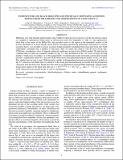EVIDENCE FOR LOW BLACK HOLE SPIN AND PHYSICALLY MOTIVATED ACCRETION MODELS FROM MILLIMETER-VLBI OBSERVATIONS OF SAGITTARIUS A*
Author(s)
Broderick, Avery E.; Fish, Vincent L.; Doeleman, Sheperd Samuel; Loeb, Abraham
DownloadBroderick-2011-EVIDENCE FOR LOW BLA.pdf (2.206Mb)
PUBLISHER_POLICY
Publisher Policy
Article is made available in accordance with the publisher's policy and may be subject to US copyright law. Please refer to the publisher's site for terms of use.
Terms of use
Metadata
Show full item recordAbstract
Millimeter very long baseline interferometry (mm-VLBI) provides the novel capacity to probe the emission region of a handful of supermassive black holes on sub-horizon scales. For Sagittarius A* (Sgr A*), the supermassive black hole at the center of the Milky Way, this provides access to the region in the immediate vicinity of the horizon. Broderick et al. have already shown that by leveraging spectral and polarization information as well as accretion theory, it is possible to extract accretion-model parameters (including black hole spin) from mm-VLBI experiments containing only a handful of telescopes. Here we repeat this analysis with the most recent mm-VLBI data, considering a class of aligned, radiatively inefficient accretion flow (RIAF) models. We find that the combined data set rules out symmetric models for Sgr A*'s flux distribution at the 3.9σ level, strongly favoring length-to-width ratios of roughly 2.4:1. More importantly, we find that physically motivated accretion flow models provide a significantly better fit to the mm-VLBI observations than phenomenological models, at the 2.9σ level. This implies that not only is mm-VLBI presently capable of distinguishing between potential physical models for Sgr A*'s emission, but further that it is sensitive to the strong gravitational lensing associated with the propagation of photons near the black hole. Based upon this analysis we find that the most probable magnitude, viewing angle, and position angle for the black hole spin are a = 0.0+0.64 + 0.86, $\theta ={68^\circ }^{+5^\circ +9^\circ }_{-20^\circ -28^\circ }$, and $\xi ={-52^\circ }^{+17^\circ +33^\circ }_{-15^\circ -24^\circ }$ east of north, where the errors quoted are the 1σ and 2σ uncertainties.
Date issued
2011-07Department
Haystack ObservatoryJournal
Astrophysical Journal
Publisher
Institute of Physics/American Astronomical Society
Citation
Broderick, Avery E., Vincent L. Fish, Sheperd S. Doeleman, and Abraham Loeb. “EVIDENCE FOR LOW BLACK HOLE SPIN AND PHYSICALLY MOTIVATED ACCRETION MODELS FROM MILLIMETER-VLBI OBSERVATIONS OF SAGITTARIUS A*.” The Astrophysical Journal 735, no. 2 (June 23, 2011): 110. © 2011 American Astronomical Society.
Version: Final published version
ISSN
0004-637X
1538-4357